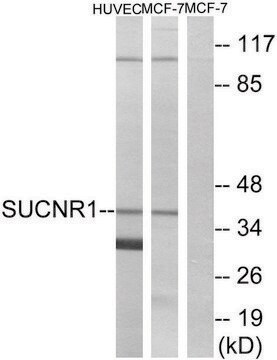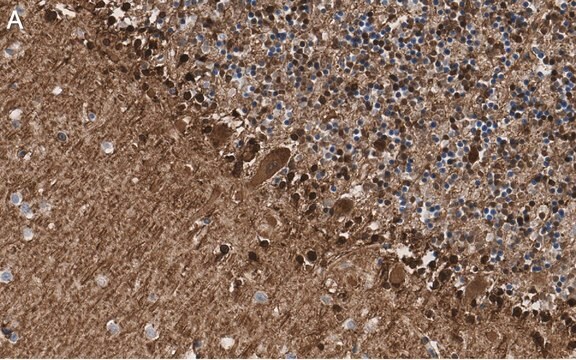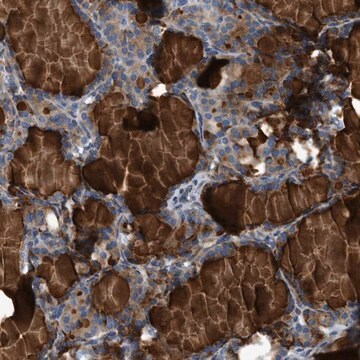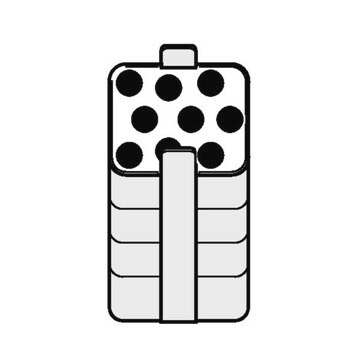ZRB2183
Anti-SUCNR1/GPR91 Antibody, clone 1N21 ZooMAb® Rabbit Monoclonal

recombinant, expressed in HEK 293 cells
Synonym(s):
Anti-CD11a Antibody, clone 2J15 ZooMAb® Rabbit Monoclonal, G-protein coupled receptor 91, P2Y purinoceptor 1-like, Succinate receptor 1
About This Item
IF
IHC
WB
affinity binding assay
affinity binding assay: suitable
immunofluorescence: suitable
immunohistochemistry: suitable
western blot: suitable
Recommended Products
biological source
rabbit
Quality Level
recombinant
expressed in HEK 293 cells
conjugate
unconjugated
antibody form
purified antibody
antibody product type
primary antibodies
clone
1N21, recombinant monoclonal
description
recombinant, expressed in HEK 293 cells
product line
ZooMAb® learn more
form
lyophilized
mol wt
calculated mol wt 38.7 kDa
purified by
using Protein A
species reactivity
porcine, human
packaging
antibody small pack of 25
greener alternative product characteristics
Waste Prevention
Designing Safer Chemicals
Design for Energy Efficiency
Learn more about the Principles of Green Chemistry.
enhanced validation
recombinant expression
Learn more about Antibody Enhanced Validation
sustainability
Greener Alternative Product
technique(s)
ELISA: suitable
affinity binding assay: suitable
immunofluorescence: suitable
immunohistochemistry: suitable
western blot: suitable
isotype
IgG
epitope sequence
C-terminal half
Protein ID accession no.
UniProt accession no.
greener alternative category
shipped in
ambient
storage temp.
2-8°C
Gene Information
human ... SUCNR1(56670)
General description
Specificity
Immunogen
Application
Evaluated by Immunohistochemistry (Paraffin) in Human breast cancer tissue sections.
Immunohistochemistry (Paraffin) Analysis: A 1:100 dilution of this antibody detected SUCNR1/GRP91 in Human breast cancer tissue sections.
Tested Applications
Affinity Binding Assay: A representative lot of this antibody bound SUCNR1/GPR91 peptide with a KD of 3.5 x 10^-8 in an affinity binding assay.
Western Blotting Analysis: A 1:1,000 dilution from a representative lot detected SUCNR1/GPR91 in human adipose tissue lysates.
Enzyme Immunoassay (ELISA) Analysis: A serial of dilutions from a representative lot detected SUCNR1/GPR91 in SUCNR1 and GST Proteins.
Immunofluorescence Analysis: A 1:5,000 dilution from a representative lot detected SUCNR1/GPR91 in Human liver and porcine kidney tissue sections.
Note: Actual optimal working dilutions must be determined by end user as specimens, and experimental conditions may vary with the end user.
Target description
Physical form
Reconstitution
Storage and Stability
Legal Information
Disclaimer
Not finding the right product?
Try our Product Selector Tool.
Storage Class Code
11 - Combustible Solids
WGK
WGK 1
Flash Point(F)
Not applicable
Flash Point(C)
Not applicable
Choose from one of the most recent versions:
Certificates of Analysis (COA)
Sorry, we don't have COAs for this product available online at this time.
If you need assistance, please contact Customer Support.
Already Own This Product?
Find documentation for the products that you have recently purchased in the Document Library.
Our team of scientists has experience in all areas of research including Life Science, Material Science, Chemical Synthesis, Chromatography, Analytical and many others.
Contact Technical Service







